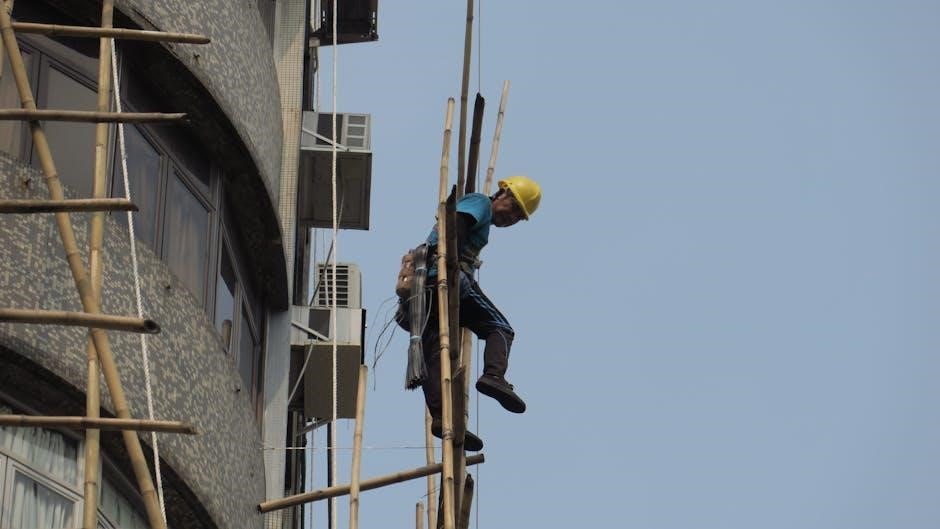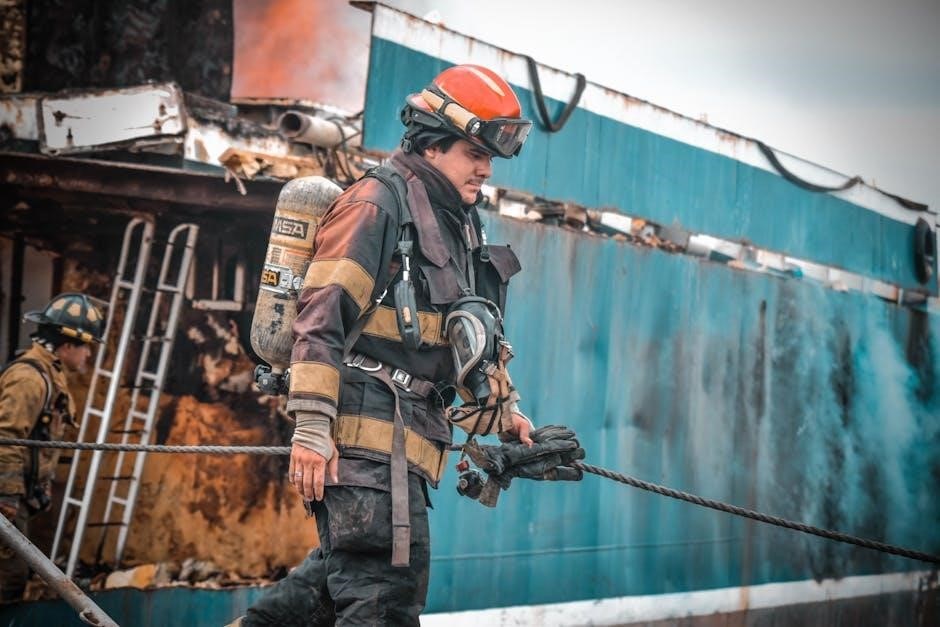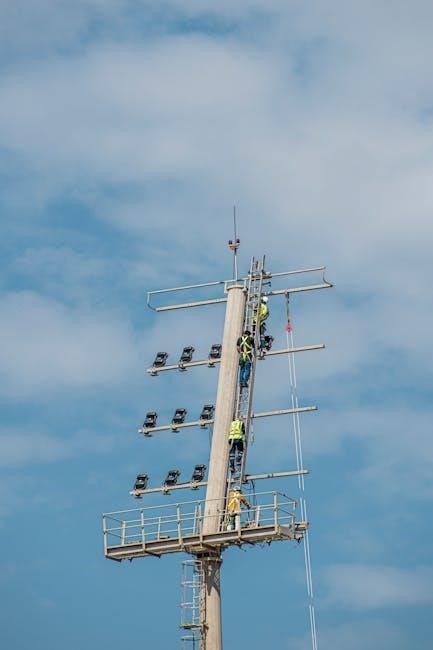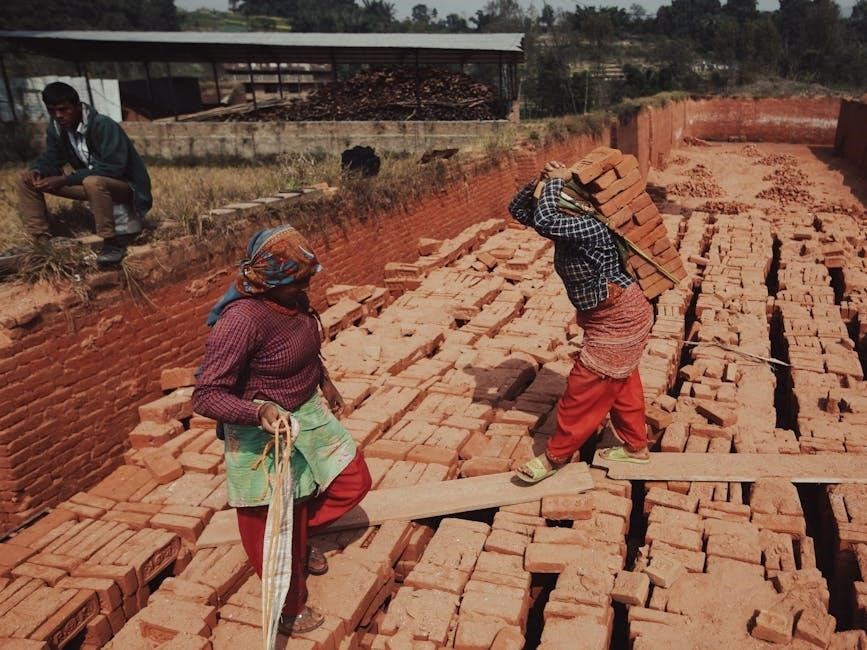Lone working risk assessment is crucial for ensuring worker safety and compliance with legal requirements. It involves identifying hazards, evaluating risks, and implementing controls to protect lone workers effectively.
1.1. Definition and Importance of Lone Working Risk Assessment
Lone working risk assessment is a systematic process to identify, evaluate, and mitigate risks associated with employees working alone. It is essential for ensuring compliance with legal requirements and safeguarding worker well-being. By analyzing hazards specific to lone working scenarios, employers can implement targeted controls to reduce risks. This process is vital for protecting lone workers, who often face unique challenges without direct supervision. Conducting regular assessments ensures a safe working environment and demonstrates an organization’s commitment to employee safety and legal compliance.
1.2. Purpose of Conducting a Lone Working Risk Assessment
The primary purpose of a lone working risk assessment is to identify and mitigate risks specific to employees working alone. It ensures compliance with legal obligations and prioritizes worker safety. By evaluating hazards, employers can implement effective controls to minimize risks. Regular assessments also promote a safer work environment and demonstrate an organization’s commitment to protecting its employees. This process is essential for safeguarding lone workers, who often face unique challenges without direct supervision, and for maintaining a proactive approach to health and safety management.
1.3. Legal Requirements for Lone Worker Safety
Lone worker safety is governed by specific legal requirements, including the Health and Safety at Work Act and the Management of Health and Safety at Work Regulations. Employers must conduct risk assessments for lone workers to ensure their safety and comply with legal obligations. These laws mandate that employers identify hazards, evaluate risks, and implement measures to protect lone workers. Non-compliance can result in legal action. The risk assessment must be documented, particularly for high-risk activities, ensuring a proactive approach to safeguarding employees working alone.

Understanding Lone Working and Its Risks
Lone working involves tasks performed by employees without direct supervision, exposing them to unique risks. Understanding these risks is essential for safeguarding workers and ensuring compliance with safety protocols.
2.1. What Constitutes Lone Working?
Lone working refers to situations where employees perform tasks without direct supervision, often in isolated locations or during non-traditional hours. This includes scenarios like working late, performing maintenance, or traveling for work. Lone workers may operate in low-risk environments, such as offices, or high-risk settings, like construction sites. The absence of immediate assistance or support is a key factor in defining lone working. Both full-time and part-time lone workers face unique challenges, making it essential to identify and mitigate risks specific to their roles.
2.2. Common Hazards Faced by Lone Workers
Lone workers often encounter physical hazards, such as equipment malfunctions or slips, and environmental risks like working in isolated or unsafe locations. Psychosocial risks, including stress and fatigue, can also arise due to the lack of direct supervision. Additionally, lone workers may face unique challenges like limited access to emergency assistance or medical care. Identifying these hazards is critical to ensuring their safety and well-being while working independently.
2.3. Industry-Specific Risks for Lone Workers
Industry-specific risks vary significantly for lone workers. For example, healthcare workers may face biological hazards, while those in manufacturing or construction encounter physical risks like equipment malfunctions. Field service workers often deal with environmental risks, such as working in remote or unstable locations. Additionally, industries like transportation or delivery may expose lone workers to vehicular hazards or unpredictable public interactions. Understanding these industry-specific risks is essential for conducting effective risk assessments and implementing targeted safety measures to protect lone workers in diverse sectors.

The Lone Working Risk Assessment Process
Lone working risk assessment involves identifying hazards, evaluating risks, and implementing controls to ensure worker safety. This systematic approach minimizes risks and protects lone workers effectively.
3.1. Identifying Hazards Specific to Lone Working
Identifying hazards specific to lone working involves recognizing potential risks unique to isolated work environments. Common hazards include slips, trips, falls, medical emergencies, and environmental risks like extreme temperatures. Additionally, lone workers may face psychosocial risks, such as stress or violence from others. The process requires assessing the workplace, the nature of the task, and individual vulnerabilities. Tools like risk assessment forms and checklists help systematically identify these hazards, ensuring a comprehensive evaluation to protect workers and meet legal standards. This step is crucial for developing effective safety measures.
3.2. Evaluating the Risks (Low/Medium/High)
Evaluating risks involves categorizing hazards as low, medium, or high based on their likelihood and potential impact. Low risks pose minimal harm, while high risks require immediate attention. Factors such as the nature of the task, environmental conditions, and individual worker vulnerabilities are considered. This evaluation ensures that control measures are proportionate to the risks identified. Proper documentation and regular reviews are essential to maintain accuracy and compliance with safety standards, ensuring lone workers are adequately protected from harm.
3.3. Implementing Control Measures
Implementing control measures is essential to mitigate risks identified during the lone working risk assessment. This includes establishing communication systems, emergency response plans, and regular check-ins. Employers should provide personal protective equipment (PPE) and ensure lone workers have access to panic buttons or GPS tracking devices. Documentation of control measures is crucial for compliance and accountability. Regular reviews and updates ensure the effectiveness of these measures, safeguarding lone workers from potential hazards and ensuring a secure working environment tailored to their specific needs and circumstances.
Monitoring and Reviewing the Risk Assessment
Regular monitoring and reviewing of the risk assessment ensure its effectiveness and relevance. Updates are made based on new hazards, incidents, or changes in work conditions, ensuring ongoing safety for lone workers.
4.1. Regular Updates to the Risk Assessment
Regular updates to the risk assessment are essential to ensure it remains relevant and effective. Changes in workplace conditions, new equipment, or employee roles may introduce new hazards. Employers should review and update the assessment periodically or after incidents. This ensures that lone workers are protected from evolving risks. Updates should be documented and communicated to all relevant parties. Regular audits and feedback from lone workers can help identify areas needing revision. Proactive updates enhance safety and compliance with legal requirements, ensuring a robust safety framework for lone workers.
4.2. Involving Employees in the Review Process
Involving employees in the review process enhances the effectiveness of lone working risk assessments. Workers often provide valuable insights into specific hazards and challenges they face. Encouraging feedback through surveys, focus groups, or direct consultations ensures that their concerns are addressed. Employees should also participate in updating risk assessments, especially when their roles or environments change. This collaboration fosters a safety-oriented culture, ensuring that controls are practical and effective. Active involvement also increases employee commitment to adhering to safety protocols, ultimately improving lone worker safety outcomes.

Factors Influencing Lone Working Risk Levels
Environmental factors, such as location and time of work, and individual vulnerabilities, like health conditions or past incidents, significantly influence lone working risk levels and safety outcomes.
5.1. Environmental Factors
Environmental factors significantly influence lone working risks, including location, time of day, and weather conditions. Isolated or remote workspaces increase vulnerability, while poor lighting or uneven terrain can heighten accident risks. Additionally, unpredictable environments, such as those prone to natural disasters or extreme weather, further exacerbate potential dangers. Understanding these factors is essential for conducting thorough risk assessments and implementing tailored safety measures to protect lone workers in diverse settings.
5.2. Individual Vulnerabilities of Lone Workers
Individual vulnerabilities, such as medical conditions, physical limitations, or mental health concerns, can increase risks for lone workers. Certain health issues may impair a worker’s ability to respond to emergencies, while physical constraints could limit mobility or strength. Additionally, mental health stressors, such as anxiety or isolation, can heighten susceptibility to workplace hazards. Employers must consider these factors during risk assessments to ensure appropriate safety measures are in place, protecting workers with specific needs while maintaining their ability to perform tasks safely.

Best Practices for Lone Worker Safety
Best practices include regular communication check-ins, real-time monitoring, PPE, training, and emergency response plans to ensure safety and address potential risks effectively for lone workers.
6.1. Communication and Check-In Systems
Implementing reliable communication and check-in systems is vital for lone worker safety. Regular check-ins ensure employers are aware of workers’ whereabouts and safety. Automated or manual systems can be used, with real-time monitoring to quickly respond to emergencies. Clear communication protocols, including emergency contact procedures, help mitigate risks. Employers should also maintain records of check-ins to ensure compliance and accountability. These systems are essential for promptly addressing incidents and ensuring lone workers receive timely assistance when needed, enhancing overall safety and operational efficiency.
6.2. Personal Protective Equipment (PPE)
Personal Protective Equipment (PPE) plays a critical role in mitigating risks for lone workers. Employers should assess job-specific hazards and provide appropriate PPE, such as high-visibility clothing, safety shoes, or respiratory masks. Regular maintenance and inspections of PPE are essential to ensure effectiveness. Workers should also receive training on proper usage and care of PPE to maximize protection. Tailoring PPE to individual roles and environments helps reduce injury risks and enhances overall safety, particularly in high-risk or remote settings where immediate assistance may be delayed.
6.3. Training for Lone Workers
Training is essential for lone workers to identify and manage risks effectively. Employers should provide tailored training programs that cover hazard identification, emergency response, and the proper use of PPE. Regular updates and refresher courses ensure workers stay informed about new risks and procedures. Practical exercises and scenario-based training can enhance preparedness for real-life situations. This comprehensive approach empowers lone workers to make informed decisions, ensuring their safety and well-being while working independently.

Emergency Procedures for Lone Workers
Establishing clear emergency procedures is vital for lone workers, including real-time monitoring systems and prompt assistance protocols to ensure their safety during critical situations.
7.1. Establishing an Emergency Response Plan
A comprehensive emergency response plan for lone workers is essential to ensure timely assistance during critical situations. It should include clear protocols for identifying emergencies, communication methods, and real-time monitoring systems. Employers must outline procedures for immediate response, such as emergency contacts and evacuation routes. Regular drills and updates to the plan are necessary to adapt to changing work environments and ensure the safety of lone workers. This plan must be integrated into the overall lone working risk assessment to provide a robust safety net.
7.2. Using Technology for Real-Time Monitoring
Technology plays a vital role in real-time monitoring of lone workers, enhancing their safety and enabling swift responses to emergencies. GPS tracking devices, panic buttons, and mobile apps allow employers to monitor workers’ locations and receive instant alerts in case of distress. Automated check-in systems ensure regular communication, while wearable devices can detect falls or immobility. These tools integrate with emergency response plans, ensuring timely assistance. Regular updates to monitoring systems are crucial to maintain reliability and adapt to evolving risks, providing a proactive approach to lone worker safety.

Developing a Lone Worker Policy
A lone worker policy is essential for outlining procedures, responsibilities, and safety measures. It ensures compliance with legal standards and minimizes risks through clear guidelines and hazard identification.
8.1. Key Components of a Lone Worker Policy
A comprehensive lone worker policy should include hazard identification, risk evaluation, and control measures. It must outline procedures for emergency situations, communication protocols, and training requirements. The policy should also define responsibilities for both employers and employees, ensuring accountability. Regular reviews and updates are essential to adapt to changing work conditions. Additionally, it should address individual vulnerabilities and provide guidelines for reporting incidents. A well-structured policy ensures compliance with legal standards and fosters a safe working environment for lone workers.
8.2. Ensuring Policy Compliance
Ensuring compliance with a lone worker policy requires consistent training, clear communication, and regular audits. Employers must provide ongoing education on safety protocols and emergency procedures. Supervisors should conduct regular checks to verify adherence to guidelines. Technology, such as monitoring systems, can help track compliance in real-time. Additionally, fostering a culture of safety encourages employees to report incidents and suggest improvements. Regular feedback mechanisms ensure policies remain effective and up-to-date, promoting a safer environment for lone workers while meeting legal obligations.

Case Studies and Real-World Applications
Real-world applications highlight successful lone worker risk assessments, demonstrating reduced incidents and improved safety protocols. Case studies reveal practical strategies and lessons learned, enhancing workplace safety.
9.1. Successful Implementation of Lone Worker Risk Assessments
Successful implementations of lone worker risk assessments have significantly reduced incidents and enhanced workplace safety. For instance, companies like Reliance High-Tech have integrated advanced monitoring systems, ensuring real-time tracking and emergency response. Industries such as healthcare and manufacturing have adopted tailored risk assessment templates, addressing specific hazards like slips or equipment malfunctions. Regular updates and employee feedback have been crucial in refining these strategies, demonstrating the effectiveness of proactive risk management in safeguarding lone workers across diverse environments.
9.2. Lessons Learned from Incident Reports
Incident reports reveal critical insights into lone worker safety breaches, highlighting common risks like communication failures and delayed emergency responses. Many incidents stem from inadequate hazard identification or insufficient control measures. For example, lone workers in high-risk environments often face challenges in emergencies due to poor visibility or lack of real-time monitoring. These reports underscore the importance of robust communication systems, regular health checks, and tailored risk assessments. Lessons learned emphasize the need for proactive measures to mitigate risks and ensure timely assistance, preventing future incidents and enhancing overall safety protocols.

Tools and Templates for Lone Working Risk Assessment
Downloadable PDF templates and specialized software solutions simplify lone worker risk assessments, enabling organizations to identify hazards, evaluate risks, and implement controls effectively.
10.1. Downloadable Lone Working Risk Assessment Templates
Downloadable lone working risk assessment templates in PDF format provide structured frameworks for identifying hazards, evaluating risks, and documenting control measures. These templates are customizable to suit various workplace environments and activities. They include sections for hazard identification, risk evaluation (low/medium/high), and implementation of safety measures. Organizations can use these templates to ensure compliance with legal requirements and maintain consistency in their risk assessment processes. They are particularly useful for employers managing lone workers across different industries and roles, offering a practical tool to enhance worker safety and meet regulatory standards effectively.
10.2. Software Solutions for Managing Lone Worker Safety
Software solutions for managing lone worker safety provide advanced tools for real-time monitoring, GPS tracking, and emergency response. These systems often integrate with risk assessment templates, enabling seamless hazard identification and control implementation. Features like automated check-ins, panic buttons, and data analytics enhance worker safety and compliance. Platforms such as Reliance High-Tech and Transforms Form Generator provide customizable options, ensuring tailored safety protocols. These technologies are essential for organizations aiming to protect lone workers effectively in diverse environments.

Consulting with Experts and Stakeholders
Collaborating with health and safety professionals ensures comprehensive risk assessments and effective strategies to minimize lone worker risks. Employee engagement further enhances safety and compliance.
11.1. Collaborating with Health and Safety Professionals
Collaborating with health and safety professionals is essential for conducting thorough lone working risk assessments. Their expertise helps identify specific hazards, evaluate risks accurately, and implement effective control measures. Professionals ensure compliance with legal requirements and industry standards, providing tailored solutions to enhance lone worker safety. Regular consultations with these experts enable organizations to stay updated on best practices and adapt to evolving risks, ensuring a proactive approach to safeguarding employees. This partnership is vital for creating a robust safety framework.
11.2. Engaging Employees in the Risk Assessment Process
Engaging employees in the risk assessment process is vital for ensuring their safety and fostering a culture of responsibility. Employees often have firsthand insights into the specific risks they face while working alone, making their input invaluable. By involving them, organizations can identify hazards that might otherwise go unnoticed and develop practical control measures. This collaboration not only enhances the effectiveness of the risk assessment but also encourages employees to take an active role in maintaining their own safety and that of their colleagues. Regular feedback loops ensure ongoing improvement in lone worker safety protocols.
Lone working risk assessments ensure worker safety and legal compliance, providing a structured approach to identifying and mitigating risks. Regular updates and employee engagement are essential for effectiveness.
12.1. Summary of Key Points
Lone working risk assessments are essential for safeguarding employees and meeting legal obligations. They involve identifying hazards, evaluating risks, and implementing controls to ensure worker safety. Regular updates and employee engagement are critical for effectiveness. These assessments help organizations minimize risks, promote a safe working environment, and maintain compliance with health and safety regulations. By prioritizing lone worker safety, employers can reduce incidents and foster a culture of responsibility and care within the workplace.
12.2. Future Trends in Lone Worker Risk Management
Future trends in lone worker risk management emphasize advancements in technology, such as real-time monitoring systems and AI-driven risk assessments. GPS tracking and wearable devices will enhance safety, enabling immediate emergency responses. Integration of data analytics will help identify patterns and prevent incidents. Organizations are expected to adopt more proactive strategies, combining technology with robust policies to safeguard lone workers. These innovations will foster a safer, more efficient work environment, ensuring compliance and reducing risks effectively.

Leave a Reply
You must be logged in to post a comment.